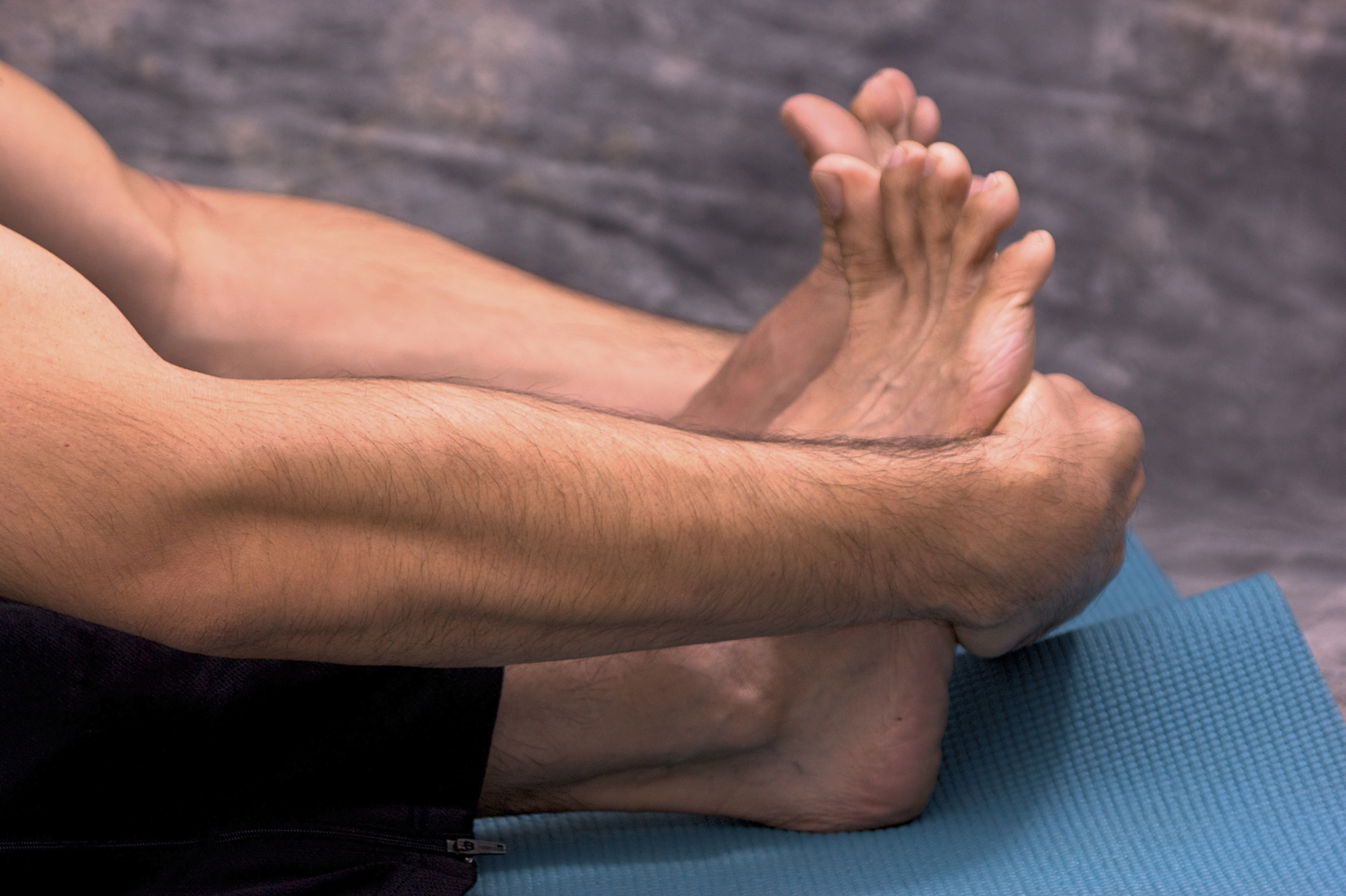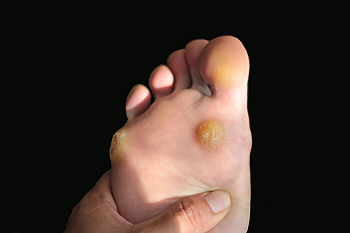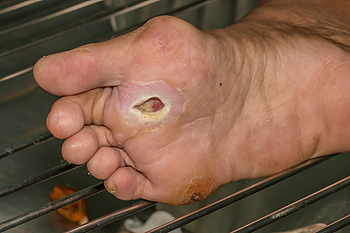Items filtered by date: May 2020
Heel Pain Can Be Treated!
How Does Hammertoe Occur?
 The second and third toes may be impacted by the medical condition that is known as hammertoe. The toe bends at the joint in an upward position, and often resembles a hammer. It is considered to be a deformity, and in severe cases, surgery may be necessary to permanently straighten the toes.There are two stages of hammertoe. When this condition is first noticed, the joints can be flexible, and relief may be found when the correct shoes are worn. Additionally, there are specific stretches that can be performed which may help to strengthen the toes. When the condition becomes more severe, it is referred to as rigid hammertoe, and the joints are unable to move. A common reason why this condition may develop can consist of wearing shoes that do not have adequate room for the toes to move freely in. Additionally, genetic factors may lead to developing hammertoe. Please consult with a podiatrist who can properly diagnose this ailment, and suggest treatment options that are correct for you.
The second and third toes may be impacted by the medical condition that is known as hammertoe. The toe bends at the joint in an upward position, and often resembles a hammer. It is considered to be a deformity, and in severe cases, surgery may be necessary to permanently straighten the toes.There are two stages of hammertoe. When this condition is first noticed, the joints can be flexible, and relief may be found when the correct shoes are worn. Additionally, there are specific stretches that can be performed which may help to strengthen the toes. When the condition becomes more severe, it is referred to as rigid hammertoe, and the joints are unable to move. A common reason why this condition may develop can consist of wearing shoes that do not have adequate room for the toes to move freely in. Additionally, genetic factors may lead to developing hammertoe. Please consult with a podiatrist who can properly diagnose this ailment, and suggest treatment options that are correct for you.
Hammertoes can be a painful condition to live with. For more information, contact one of our podiatrists of Pennsylvania. Our doctors will answer any of your foot- and ankle-related questions.
Hammertoe
Hammertoe is a foot deformity that occurs due to an imbalance in the muscles, tendons, or ligaments that normally hold the toe straight. It can be caused by the type of shoes you wear, your foot structure, trauma, and certain disease processes.
Symptoms
- Painful and/or difficult toe movement
- Swelling
- Joint stiffness
- Calluses/Corns
- Physical deformity
Risk Factors
- Age – The risk of hammertoe increases with age
- Sex – Women are more likely to have hammertoe compared to men
- Toe Length – You are more likely to develop hammertoe if your second toe is longer than your big toe
- Certain Diseases – Arthritis and diabetes may make you more likely to develop hammertoe
Treatment
If you have hammertoe, you should change into a more comfortable shoe that provides enough room for your toes. Exercises such as picking up marbles may strengthen and stretch your toe muscles. Nevertheless, it is important to seek assistance from a podiatrist in order to determine the severity of your hammertoe and see which treatment option will work best for you.
If you have any questions, please feel free to contact one of our offices located in Plymouth Meeting and Ambler, PA . We offer the newest diagnostic and treatment technologies for all your foot care needs.
Stretches You Can Perform to Help Heal a Sprained Ankle
 When healing from a sprained ankle, it’s important that you slowly and carefully build the muscles around the affected area. If you’re recovering from a mild sprain, you should be able to start practicing low impact exercises within a few days of having rested your foot. If you’re somebody who likes to regularly stay active, it’s important that you adapt your exercise routine around your sprained ankle, that way you can prevent injuring it further. The exercises you perform to help heal your ankle should focus on benefiting your range of motion, balance, strength, and flexibility. One simple exercise that can be performed to help your range of motion is referred to as ankle circles. This exercise is done by sitting in a chair with your ankle resting on the opposite knee. Slowly begin to rotate your ankle in a clockwise motion, then counterclockwise. Switch ankles and repeat this motion. Another stretch known as band pushes can be particularly beneficial for strengthening your ankle joints. To perform this stretch, sit flat on the floor with your legs straight out and place a resistance band around the ball of your foot. Begin pushing your foot against the band with your toes pointed slightly forward. For more advice on what stretches can help heal a sprained ankle, please consult with a podiatrist.
When healing from a sprained ankle, it’s important that you slowly and carefully build the muscles around the affected area. If you’re recovering from a mild sprain, you should be able to start practicing low impact exercises within a few days of having rested your foot. If you’re somebody who likes to regularly stay active, it’s important that you adapt your exercise routine around your sprained ankle, that way you can prevent injuring it further. The exercises you perform to help heal your ankle should focus on benefiting your range of motion, balance, strength, and flexibility. One simple exercise that can be performed to help your range of motion is referred to as ankle circles. This exercise is done by sitting in a chair with your ankle resting on the opposite knee. Slowly begin to rotate your ankle in a clockwise motion, then counterclockwise. Switch ankles and repeat this motion. Another stretch known as band pushes can be particularly beneficial for strengthening your ankle joints. To perform this stretch, sit flat on the floor with your legs straight out and place a resistance band around the ball of your foot. Begin pushing your foot against the band with your toes pointed slightly forward. For more advice on what stretches can help heal a sprained ankle, please consult with a podiatrist.
Stretching the feet is a great way to prevent injuries. If you have any concerns with your feet consult with one of our podiatrists from Pennsylvania. Our doctors will assess your condition and provide you with quality foot and ankle treatment.
Stretching the Feet
Being the backbone of the body, the feet carry your entire weight and can easily become overexerted, causing cramps and pain. As with any body part, stretching your feet can serve many benefits. From increasing flexibility to even providing some pain relief, be sure to give your feet a stretch from time to time. This is especially important for athletes or anyone performing aerobic exercises, but anyone experiencing foot pain or is on their feet constantly should also engage in this practice.
Great ways to stretch your feet:
- Crossing one leg over the others and carefully pull your toes back. Do 10-20 repetitions and repeat the process for each foot
- Face a wall with your arms out and hands flat against the wall. Step back with one foot and keep it flat on the floor while moving the other leg forward. Lean towards the wall until you feel a stretch. Hold for 30 seconds and perform 10 repetitions for each foot
- Be sure not to overextend or push your limbs too hard or you could risk pulling or straining your muscle
Individuals who tend to their feet by regular stretching every day should be able to minimize foot pain and prevent new problems from arising.
If you have any questions, please feel free to contact one of our offices located in Plymouth Meeting and Ambler, PA . We offer the newest diagnostic and treatment technologies for all your foot care needs.
Common Signs Of Plantar Warts
 Patients who have had a plantar wart are often aware of the pain and discomfort this ailment may cause. It is defined as a virus that forms a wart on the sole of the foot. It differs from a common wart that is found on the hands because it grows into the bottom of the foot. This is a result of the pressure that comes from walking and standing for the majority of the day. Some of the symptoms that are associated with this condition can consist of extreme pain and discomfort, and tiny black dots may form in the center of the wart. It is considered to be a contagious virus, and may live on the surfaces of public pools, locker rooms, and communal shower room floors. If you notice a small, rough area on the bottom of your foot, you may have developed a plantar wart, and it is suggested that you consult with a podiatrist who can offer you the best treatment options.
Patients who have had a plantar wart are often aware of the pain and discomfort this ailment may cause. It is defined as a virus that forms a wart on the sole of the foot. It differs from a common wart that is found on the hands because it grows into the bottom of the foot. This is a result of the pressure that comes from walking and standing for the majority of the day. Some of the symptoms that are associated with this condition can consist of extreme pain and discomfort, and tiny black dots may form in the center of the wart. It is considered to be a contagious virus, and may live on the surfaces of public pools, locker rooms, and communal shower room floors. If you notice a small, rough area on the bottom of your foot, you may have developed a plantar wart, and it is suggested that you consult with a podiatrist who can offer you the best treatment options.
Plantar warts can be very uncomfortable. If you need your feet checked, contact one of our podiatrists from Pennsylvania. Our doctors will assist you with all of your foot and ankle needs.
About Plantar Warts
Plantar warts are the result of HPV, or human papillomavirus, getting into open wounds on the feet. They are mostly found on the heels or balls of the feet.
While plantar warts are generally harmless, those experiencing excessive pain or those suffering from diabetes or a compromised immune system require immediate medical care. Plantar warts are easily diagnosed, usually through scraping off a bit of rough skin or by getting a biopsy.
Symptoms
- Lesions on the bottom of your feet, usually rough and grainy
- Hard or thick callused spots
- Wart seeds, which are small clotted blood vessels that look like little black spots
- Pain, discomfort, or tenderness of your feet when walking or standing
Treatment
- Freezing
- Electric tool removal
- Laser Treatment
- Topical Creams (prescription only)
- Over-the-counter medications
To help prevent developing plantar warts, avoid walking barefoot over abrasive surfaces that can cause cuts or wounds for HPV to get into. Avoiding direct contact with other warts, as well as not picking or rubbing existing warts, can help prevent the further spread of plantar warts. However, if you think you have developed plantar warts, speak to your podiatrist. He or she can diagnose the warts on your feet and recommend the appropriate treatment options.
If you have any questions please feel free to contact one of our offices located in Plymouth Meeting and Ambler, PA . We offer the newest diagnostic and treatment technologies for all your foot and ankle needs.
Three Phases of Wound Healing
 Patients who have wounds on their feet may experience difficulty in walking, in addition to having severe pain and discomfort. Chronic foot wounds can occur for a variety of reasons. These may include having diabetes, recovery from surgery, or if there has been a severe burn. Research has indicated there are three phases of the healing process. The first stage is referred to as the inflammatory phase in which the blood vessels naturally constrict to form a clot. This is followed by the fibroblastic stage that allows the protein source that is referred to as collagen to help the wound to heal and close. The last stage is known as the maturation phase, and as the wound continues to heal, it will typically form a scar. If you would like additional information about foot wounds, it is suggested that you speak with a podiatrist.
Patients who have wounds on their feet may experience difficulty in walking, in addition to having severe pain and discomfort. Chronic foot wounds can occur for a variety of reasons. These may include having diabetes, recovery from surgery, or if there has been a severe burn. Research has indicated there are three phases of the healing process. The first stage is referred to as the inflammatory phase in which the blood vessels naturally constrict to form a clot. This is followed by the fibroblastic stage that allows the protein source that is referred to as collagen to help the wound to heal and close. The last stage is known as the maturation phase, and as the wound continues to heal, it will typically form a scar. If you would like additional information about foot wounds, it is suggested that you speak with a podiatrist.
Wound care is an important part in dealing with diabetes. If you have diabetes and a foot wound or would like more information about wound care for diabetics, consult with one of our podiatrists from Pennsylvania. Our doctors will assess your condition and provide you with quality foot and ankle treatment.
What Is Wound Care?
Wound care is the practice of taking proper care of a wound. This can range from the smallest to the largest of wounds. While everyone can benefit from proper wound care, it is much more important for diabetics. Diabetics often suffer from poor blood circulation which causes wounds to heal much slower than they would in a non-diabetic.
What Is the Importance of Wound Care?
While it may not seem apparent with small ulcers on the foot, for diabetics, any size ulcer can become infected. Diabetics often also suffer from neuropathy, or nerve loss. This means they might not even feel when they have an ulcer on their foot. If the wound becomes severely infected, amputation may be necessary. Therefore, it is of the upmost importance to properly care for any and all foot wounds.
How to Care for Wounds
The best way to care for foot wounds is to prevent them. For diabetics, this means daily inspections of the feet for any signs of abnormalities or ulcers. It is also recommended to see a podiatrist several times a year for a foot inspection. If you do have an ulcer, run the wound under water to clear dirt from the wound; then apply antibiotic ointment to the wound and cover with a bandage. Bandages should be changed daily and keeping pressure off the wound is smart. It is advised to see a podiatrist, who can keep an eye on it.
If you have any questions, please feel free to contact one of our offices located in Plymouth Meeting and Ambler, PA . We offer the newest diagnostic and treatment technologies for all your foot care needs.

